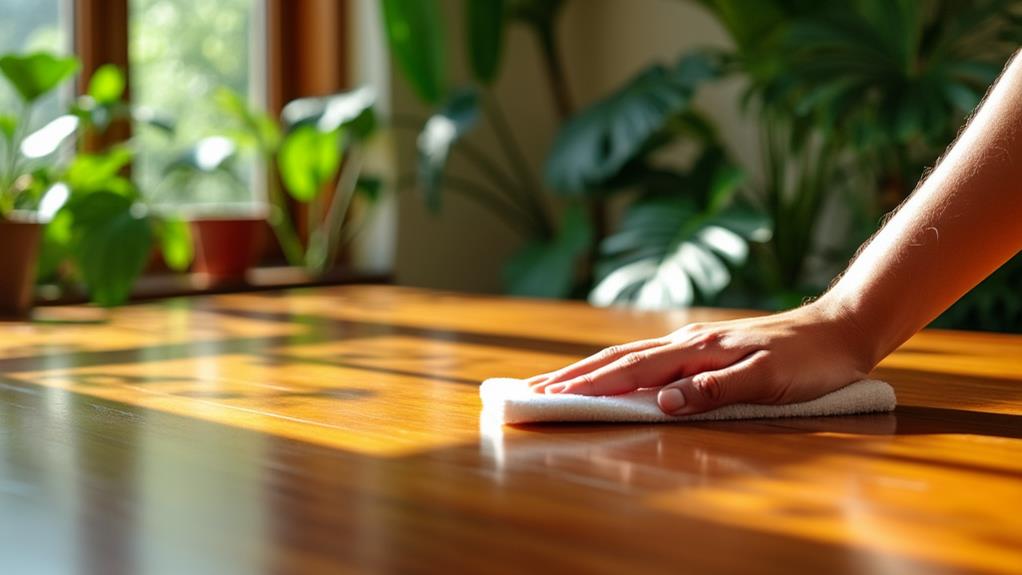To polish your wooden furniture like a pro, start by using a soft, lint-free cloth or microfiber duster to remove dust, preventing scratches. Apply polish using circular motions that follow the wood grain, focusing on small sections for uniform coverage. It's essential to use a high-quality polish compatible with your furniture's wood type and finish to guarantee ideal nourishment and protection. Avoid direct sunlight and artificial heat while allowing the polish to dry in a shaded, well-ventilated area. Regular maintenance, like dusting weekly and polishing every few months, helps preserve the finish and avoid damage. Uncover expert techniques to enhance furniture longevity.
Table of Contents
ToggleEssential Dusting Tools
Using the right tools for dusting is essential to maintaining the pristine condition of your wooden furniture.
Opt for a soft, lint-free cloth or a microfiber duster to effectively capture dust without scratching surfaces. These materials are gentle yet efficient, reducing the risk of residue buildup.
Avoid using abrasive tools and aerosols containing silicone, as they can leave unwanted residues that dull the finish.
Dusting wooden furniture at least once a week helps prevent buildup and maintains its shine. Regular dusting not only keeps the surface clean but also enhances the wood's natural beauty.
Effective Dusting Techniques
When dusting wooden furniture, start from the top and work your way down to guarantee dust doesn't resettle on already cleaned areas.
Use a soft, lint-free cloth or a microfiber duster for effective results. Avoid abrasive materials and aerosols containing silicone, which can cause residue buildup.
Employ long, sweeping motions to capture dust efficiently, preventing it from spreading. For intricate carvings and crevices, a soft-bristled brush is ideal for removing dust in hard-to-reach areas.
Dusting at least once a week is essential to prevent buildup and maintain your furniture's shine.
For stubborn spots, lightly dampen your cloth with water or a mild cleaner, ensuring you avoid excess moisture to protect and preserve your wooden surfaces.
Choosing the Right Polish
After guaranteeing your wooden furniture is dust-free, it's important to select the right polish to enhance and protect its natural beauty.
First, identify the type of wood, like oak or mahogany, as different woods may react differently to various polishes. The finish type, such as matte, satin, or high-gloss, also influences the polish choice, as each finish requires specific care to maintain its appearance.
Examine the furniture's condition; if it shows scratches or dullness, opt for restorative polishes. High-quality brands with premium ingredients are essential for nourishment and protection.
When choosing a polish, consider the following factors:
- Wood type: Matches polish with wood specifics.
- Finish type: Aligns polish with desired sheen.
- Furniture condition: Addresses surface imperfections.
- Brand quality: Guarantees effective protection and shine.
Applying Wood Polish
To apply wood polish effectively, start by verifying you have a clean, soft cloth, such as microfiber or cotton.
Begin with a small amount of polish on the cloth, applying it in circular motions while following the wood grain. This technique enhances the wood's natural beauty and prevents streaks.
Focus on small sections, guaranteeing even coverage. Once applied, use a second clean cloth to buff the surface, again employing circular motions with moderate pressure. This step is vital for achieving a smooth, uniform shine.
After buffing, inspect the furniture for any uneven spots. If necessary, apply a bit more polish to a clean cloth for targeted areas and repeat the buffing process. This guarantees a consistent and polished finish.
Optimal Drying Conditions
Guaranteeing ideal drying conditions for your wooden furniture after polishing is essential for maintaining its appearance and longevity. Proper drying prevents potential damage, such as warping and discoloration.
To achieve peak drying, avoid direct sunlight, which can cause fading and cracking. Instead, place your furniture in a shaded, well-ventilated area to promote even drying.
- Avoid using artificial heat sources, like hairdryers, as they may lead to uneven drying and damage.
- Guarantee adequate airflow around the furniture to facilitate natural drying.
- Allow the polish to dry for 15-30 minutes, following specific product instructions for best results.
- Check for complete dryness before placing any objects on your furniture to prevent imprinting or damage.
These steps help sustain your furniture's polished finish.
Regular Maintenance Tips
Establishing a regular maintenance routine is key to preserving your wooden furniture's polished finish and overall beauty.
Begin with frequent dusting, at least once a week, using a soft, lint-free cloth or microfiber duster. This prevents dust buildup and maintains shine.
For thorough cleaning, use a dampened cloth with a mild cleaner, ensuring all surfaces are covered without excess moisture.
Regularly polish furniture every 3 to 6 months, depending on usage. Select a polish that matches your wood and finish type, and apply it using circular motions to enhance the natural grain.
Monitor the furniture for scratches or dullness, addressing them promptly. Protect your furniture from excessive sunlight and humidity, storing it away from heat sources.
Benefits of Consistent Care
Why is consistent care so essential for your wooden furniture? Consistent care safeguards your furniture's aesthetic and structural integrity.
By routinely attending to your wooden pieces, you guarantee they remain not only visually appealing but also long-lasting. Regular maintenance prevents damage, like scratches or dullness, which can accumulate over time.
Additionally, a consistent care routine has several benefits:
- Preservation of Finish: Routine dusting and polishing maintain the finish, preventing wear and tear.
- Protection from Environmental Factors: Shielding furniture from sunlight and humidity helps avoid discoloration and warping.
- Enhanced Longevity: Consistent care extends the lifespan, guaranteeing your furniture remains a staple in your home.
- Improved Aesthetics: Well-maintained furniture enhances your living space, reflecting the care invested in its upkeep.


